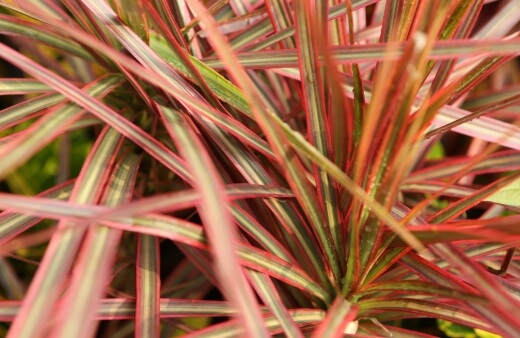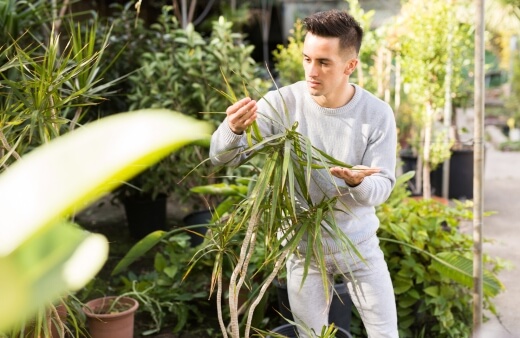Dracaena marginata is the kind of house plant you can never go wrong with – for gifting purposes, or for propagating around your own home. There is nothing better than receiving a plant as a gift for your home – even more so if the plant is easy to care for, and has some health benefits too (besides lifting your mood with its greenery).
In our how to grow and care guide, we’ll look at the varieties of Dracaena marginata, how to care for your plant, the technique for propagation and planting thereafter, common pests and diseases, and some frequently asked questions.
More...
Family: | Asparagaceae |
|---|---|
Genus: | Dracaena |
Species: | D. marginata |
Common Names: | Dragon tree, dragon plant, Madagascar dragon tree |
Location: | Indoor or outdoor |
Type: | Evergreen plant/tree |
Height: | Up to 6 metres |
Spread: | Up to 3 metres |
Sun requirements: | Full sun, part shade |
Foliage Colour: | White, green, red |
Flower Colour: | White |
Flowering: | Spring |
Fruit: | None |
Maintenance level: | Low |
Poisonous for pets: | Yes |
Introducing Dracaena marginata

Dracaena marginata as a name is quite a mouthful to remember or even pronounce – the dragon tree is the more common name for this beauty, which has green leaves that look much like swords with red edges. Very theatrical!
The plant is native to Madagascar, and so it’s sometimes also called the Madagascar dragon tree. Gardeners adore this plant because it’s so easy to look after, can handle drought, and you would probably have to seriously neglect the plant in order to kill it.
Dracaena marginata as the name suggests belongs to the Dracaena genus. It has around 120 different species of plants that are native to northern Australia, Africa and southern Asia.
Madagascar Dragon Tree Growing Habits
Dracaena marginata grows quite slowly and has little white flowers that pop up in spring time. Just a note, if you are growing the plant indoors, it doesn’t usually produce flowers.
Indoors, you’re looking at a maximum height of around 1.8 metres, but if the tree is growing outdoors in a nice warm climate, it can reach a height of up to 6 metres.
The plant is more popular as an indoor choice and because the plant can handle different light conditions, you can even move it around your home to chase the light, or mix up your home décor.
The Happy Plant is another popular choice from the Dracaena genus. You can read more about Dracaena fragrans ‘Massangeana’ and how to grow it with our guide here.
Dracaena marginata Varieties
There are plenty of varieties of Dracaena marginata to choose from but the ones that are usually chosen for a home are:
Dracaena marginata ‘Tricolor’You’ll know this variety by green leaves, with a dark red outline and whitish stripe down the middle of the leaf. |  |
Dracaena marginata ‘Colorama’This variety has lots of white and green stripes. It needs lots of light to maintain a gorgeous colour. |  |
Dracaena marginata ‘Bicolor’This variety has both red and green striped leaves. |  |
Dracaena marginata ‘Tricolor’

You’ll know this variety by green leaves, with a dark red outline and whitish stripe down the middle of the leaf.
Dracaena marginata ‘Colorama’

This variety has lots of white and green stripes. It needs lots of light to maintain a gorgeous colour.
Dracaena marginata ‘Bicolor’

This variety has both red and green striped leaves.
How to Grow Dracaena marginata
Sunlight Preference
Dracaena marginata is a big fan of indirect bright light but they can be happy in a whole range of lighting conditions so part shade is also fine.


Get Your Free Guide:
Master Growing Australian Natives eBook
A Must Have Complete Guide for Every Australian Garden
Get Your Free Guide:
Master Growing Australian Natives eBook
A Must Have Complete Guide for Every Australian Garden
Just a tip – if your plant gets less light it will grow more slowly and the leaves will be smaller. You might also notice a duller colour on the leaves. Never put your plant in direct sunlight – it will end up burning the leaves.

Soil
If your Dracaena marginata is going to be living in a pot, you need to choose a well-draining potting mix. Loam soil is great and this plant will need space for its roots to spread out so make sure your pot allows enough room for this.
Click here to learn more about loam soil and its ingredients.
Temperature and Humidity
Dracaena marginata likes a warm temperature – the ideal is between 21 and 27 degrees Celsius. In terms of humidity, if you find that your house is dry, you can mist the plant with a spray bottle every couple of days.
Dracaena marginata Propagation
If you are looking at growing your own Dracaena marginata, you’re in for an easy job. Propagation with a stem cutting in water is super simple. Try and do this in spring when the plant is growing at full speed.
The cuttings take about 3 weeks for roots to start sprouting and you don’t even need any rooting hormone.

When you’re ready to plant your cutting, here are some guidelines to follow:
Propagating Dracaena marginata in a Pot
If your cutting is going to live in the pot, you want to ensure you’ve got a great soil mixture and adding about a third of compost to the soil quantity is recommended.
You want to make sure that the drainage is good – you can use small stones for example at the bottom of the pot and create a filter layer. This makes sure your plant roots won’t be swimming in water.
You might need to repot your Dracaena marginata during the spring every 3 years.
Growing Madagascar Dragon Tree Outdoors
If you are planning to plant outside, remember that Dracaena marginata likes a warmer temperature. They really can’t handle the cold. As a guideline, if the temperature drops below 17 degrees Celsius in winter, you’ll need to rethink the outdoors as a planting site.
In the same way that you would plant in a pot, you can create a filter bed with small stones to help drain the water. On top of your drainage layer, you can then add a mix of garden soil, a soil mix, and some sand.
Caring for Dracaena marginata

Watering Needs
Dracaena marginata is drought tolerant. That means you could easily end up giving the tree too much water. Not sure how often to water? Let the top half of the soil become dry and then water – a time estimate on this is about every 3 weeks.
If you notice brown tips on the leaves you know that you could be giving too much water. Yellow leaves on the other hand usually mean the plant is thirsty.
What Fertiliser to Use
Your Dracaena marginata doesn’t really need fertiliser to be happy and healthy. If you want to help their growth along, you can fertilise at the start of spring with a control release liquid fertiliser.
Pruning Dracaena marginata
You might notice that your Dracaena marginata drops off its dead leaves. This is normal and healthy. If you want to keep your plant looking its best, you can prune off leaves that look like they’re about to fall off. If you’re looking to adjust the plant height, you can cut back the stems.
Every gardener is always looking for tips on how to better grow and care for their prized trees and plants. We understand this, and so we’ve got an extensive guide specific to Australian gardens.
Whether you need some advice around pest control, how to care for your soil, or how best to deal with a small garden space, we can help you out with some guidance and inspiration.
Possible Madagascar Dragon Tree Pests and Diseases
Dracaena marginata doesn’t struggle too much with disease but there are some pests to keep a lookout for. These include:
- Scale
- Mealybugs
- Thrips
- Spider mites
You’ll know you’re dealing with mealybugs when you find small and sticky looking cotton on the leaves. Spider mites love warm and dry temperatures but they are a bit tougher to spot and by the time you do, they might have already done some serious damage to the plant.
You can spray the spider mites with water to help move them along. For scale and mealybugs, you can prune the affected parts of the plant and then try the following:
- Treat the affected parts of the plant with rubbing alcohol
- Use neem oil or insecticidal soap
- Spray with horticultural oil
Here are some other signs to look out for on your Dracaena marginata:
- Leaves are falling or are withered – this could be because the plant is not getting enough light, or the plant is getting too much water. Adjust your watering accordingly.
- Plant is losing its leaves – this could mean your plant is getting cold. It prefers a temperature above 21 degrees Celsius, with a minimum temperature of 17 degrees.
- Leaves are turning yellow - it is normal for the plant to lose some of its bottom leaves and sometimes the leaves turn yellow before they fall off. If you notice that lots of leaves are turning yellow and drooping, you might be overwatering.
- Leaves have brown spots – if your plant gets too much sun or if the air is too dry, your plant might be thirsty. If your plant is in a pot, you can put it on a tray of pebbles and cover them with water. This helps to provide moisture that the plant needs.
- Leaves have brown tips – if you’ve been using tap water for your plant, there might be too much fluoride in the water. Try and use rainwater if possible.
Dracaena marginata Frequently Asked Questions

Is Dracaena marginata toxic to humans and pets?
This might be surprising but the plant won’t harm a person if they did eat it. Pets on the other hand are a different story and the plant is very toxic to them. You’ll need to make sure that your pets don’t have access to the plant.
How long can a Dracaena marginata live for?
The lifespan of this plant can be a few decades if it stays healthy and for plants that are living outdoors in the ground. If you are growing the plant in a pot, it could probably live around 15 years.
What is the meaning of the name Dracaena?
This word originates from ancient Greek and is based on the word ‘drakaina’ which means female dragon.
Does Dracaena marginata have any health benefits?
When grown as a houseplant, it’s excellent to purify the air – it removes toxic chemicals like formaldehyde, benzene, and carbon dioxide. Exposure to these chemicals can affect your health and could cause headaches or breathing problems.
If you enjoyed learning about Dracaena marginata, and want to learn about more of Australia’s gorgeous flora, sign up for our newsletter.
Enjoy That Madagascar Feel with the Dracaena marginata
A beautiful and structural house plant that is easy to care for and has health benefits – that sounds like a gardener’s dream. Dracaena marginata is impressive for all these reasons and makes a welcome addition to any home.
They are easily propagated and don’t ask for much in terms of care. Enjoy cleaner air and a good looking evergreen plant. We’re giving Dracena marginata our green thumbs up.
Published on September 1, 2022 by Maisie Blevins
Last Updated on February 22, 2024




